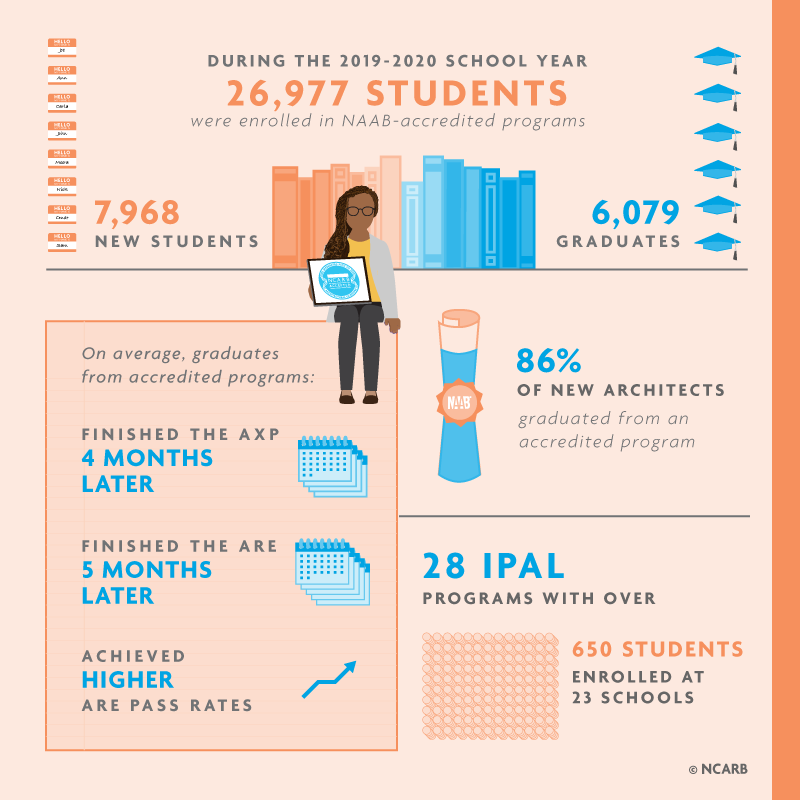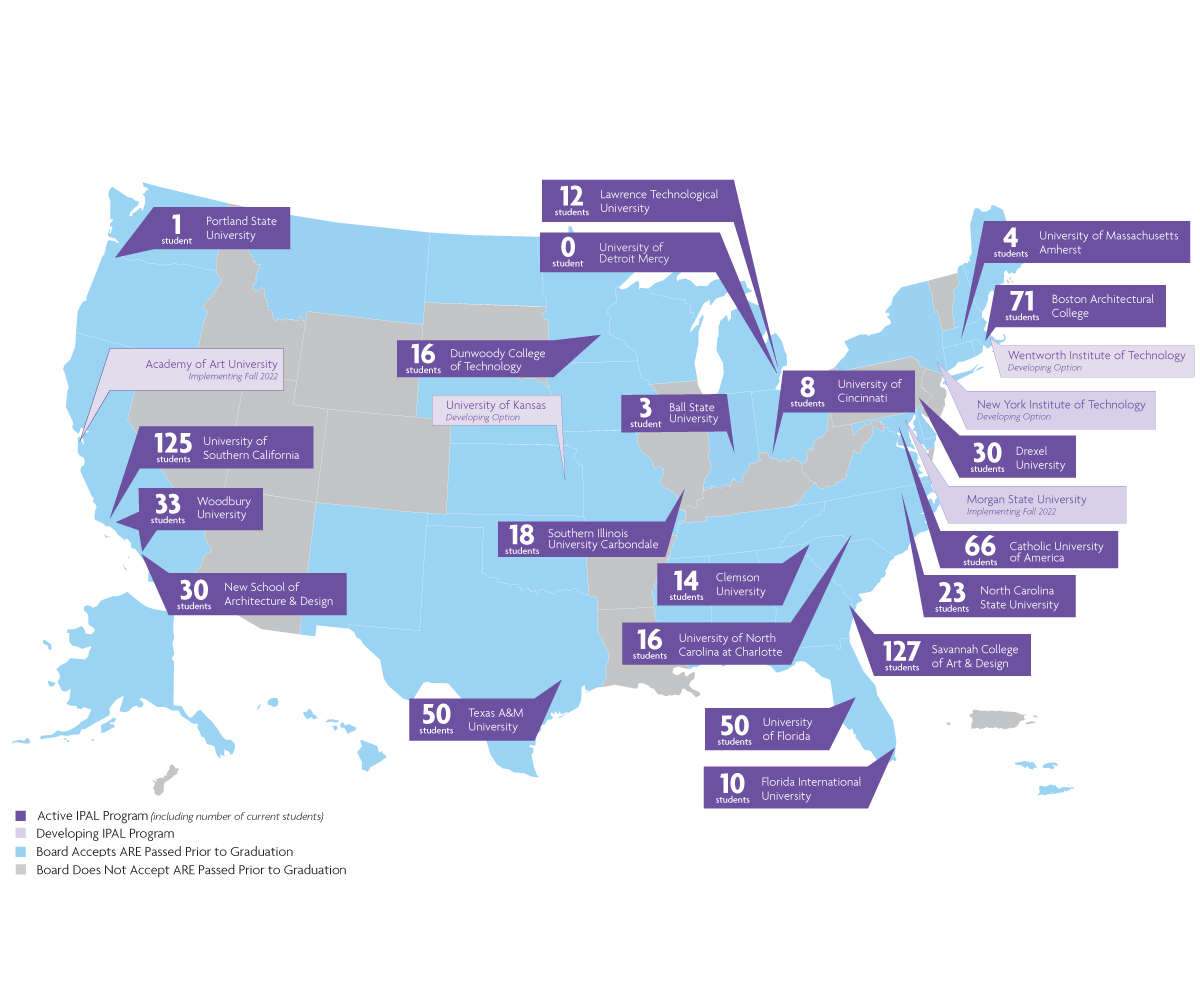Earning a degree from an architecture program accredited by the National Architectural Accrediting Board (NAAB) remains the most common path for candidates seeking architectural licensure in the United States. Data continues to show that, on average, licensure candidates with a degree from a NAAB-accredited program have greater success when taking the ARE. The NAAB’s 2020 data also reveals that both new and total enrollment in accredited programs continue to increase. And, after remaining steady for the past two years, the number of graduates from NAAB-accredited programs increased slightly to just over 6,000. Approximately 59 percent of those degrees were earned at Master of Architecture programs.

The number of students enrolled in IPAL programs continues to increase, with 650 students across the United States as of the 2019-2020 school year. Additionally, roughly 53 percent of newly licensed architects started their NCARB Record while in school, suggesting that NCARB’s continued efforts to raise early awareness of the licensure process are helping students make early progress on their path.
NAAB data shows nearly 8,000 new students enrolled in a NAAB-accredited program in the 2019-2020 school year—roughly a 3 percent increase from the previous school year. Of the new students, 48 percent are enrolled in Master of Architecture programs, and 51 percent are enrolled in Bachelor of Architecture programs. Less than 1 percent are enrolled in Doctor of Architecture programs.
Just over half of new students are women (51 percent), which is 4 percentage points higher than the proportion of female candidates reporting experience. This suggests that NCARB may see greater gender representation on the licensure path in the years to come.
Note: This data is provided to the NAAB by accredited programs and will be published in the 2020 NAAB Report on Accreditation in Architecture, available at www.naab.org. Students enrolled in non-accredited architecture programs are not represented.
Nearly 27,000 students were enrolled in a NAAB-accredited program in the 2019-2020 school year, an increase of 4 percent compared to the previous academic year. This is the third consecutive year of steady increases.
Of these students, 60 percent are enrolled in Bachelor of Architecture programs, 39 percent in Master of Architecture programs, and less than 1 percent in Doctor of Architecture programs. Fifty percent are men, and 50 percent are women.
Note: This data is provided to the NAAB by accredited programs and will be published in the 2020 NAAB Report on Accreditation in Architecture, available at www.naab.org. Students enrolled in non-accredited architecture programs are not represented.
In 2020, 6,079 degrees were awarded by NAAB-accredited programs across the country, a 2 percent increase compared to the previous school year. This is only slightly lower than the average number of graduates seen over the past decade (6,145).
Of these graduates, 50 percent were men and 50 percent were women—a 3 percentage point increase in gender equity compared to 2019, when women represented 47 percent of graduates.
Note: This data is provided to the NAAB by accredited programs and will be published in the 2020 NAAB Report on Accreditation in Architecture, available at www.naab.org. Students enrolled in non-accredited architecture programs are not represented.
Of all individuals who completed the path to licensure in 2020, 53 percent started their NCARB Record while in school—a 3 percentage point increase from 2019. This proportion has more than doubled in the past decade and may reflect NCARB’s efforts to encourage candidates to start the path to licensure early.
Creating an NCARB Record is considered one of the first steps on the path to licensure because it enables students to begin reporting experience. The growing trend of architects starting their Record in school (and having more overlap between education, experience, and education) may lead to decreases in the amount of time to complete licensing requirements for future candidates.
Note: Historical data can shift because licensure candidates can backdate AXP experience up to five years.
Similar to the previous year, roughly 86 percent of licensure candidates who completed the path to licensure in 2020 held a degree from a NAAB-accredited program.
While this percentage has seen little fluctuation over the years, the proportion of graduates who hold a degree from a NAAB-accredited program has decreased by 5 percentage points after a peak in 2016 at 91 percent.
Candidates in accredited programs took approximately 4 months longer to complete experience requirements than candidates in non-accredited programs, at 4.8 and 4.5 years respectively.
Though candidates in non-accredited programs have historically taken longer to complete the AXP, the amount of time it takes all candidates to complete the program has declined significantly since 2013. 2020 marked the first year since 2013 that the time to complete the AXP has increased for candidates from non-accredited programs. The amount of time for candidates in accredited programs has seen gradual increases each year since 2017.
In 2020, individuals who don’t hold a degree from a NAAB-accredited program finished the national licensing exam approximately five months sooner than individuals who graduated from NAAB-accredited programs.
Similar to 2019, this is a reversal of the historical trend where graduates from accredited programs typically completed the exam several months before their counterparts.
Because most candidates hold a degree from a NAAB-accredited program, this shift is likely influenced by the recent increase in the amount of time candidates take to complete the exam (see Time to Complete Exam Increases).
Despite taking longer to complete the exam, graduates of NAAB-accredited programs consistently perform better than their counterparts. In 2020, graduates from accredited programs had a success rate of roughly 57 percent, about 3 percentage points higher than the average pass rate across all ARE 5.0 divisions ; this is also 6 percentage points higher than graduates from non-accredited programs.
Historically, candidates from accredited programs outperform their peers by 6 to 9 percentage points. The average ARE 5.0 success rate increased by 2 percentage points in 2020 (see ARE Success Rate Shows Slight Improvement).
Candidates holding a master’s degree consistently have higher ARE success rates than candidates holding a bachelor’s degree.
In 2020, master’s graduates had a success rate of 58 percent, roughly 4 percentage points higher than candidates with a bachelor’s degree. This gap is on par with recent years, which all have a difference of roughly 4 percentage points. Success rates for both groups increased by 2 percentage points in 2020.
IPAL Students Across the U.S.

There are currently 28 NAAB-accredited programs at 23 colleges participating in NCARB’s Integrated Path to Architectural Licensure (IPAL) initiative, which launched in 2015.
The IPAL option—offered as an additional path within an existing NAAB-accredited program—seeks to shorten the time it takes to become an architect for students dedicated to earning a license. Participating programs provide students with the opportunity to complete the AXP and take all six ARE 5.0 divisions prior to graduation.
As of the 2019-2020 school year, nearly 650 students had enrolled in IPAL options across the United States, and nearly 80 have begun taking the ARE. Currently, 33 boards will accept licensure applications from candidates who have completed the ARE prior to graduation through an IPAL program.
Note: Enrollment data is from the 2019-2020 school year. Some accepted programs are still developing their IPAL options.